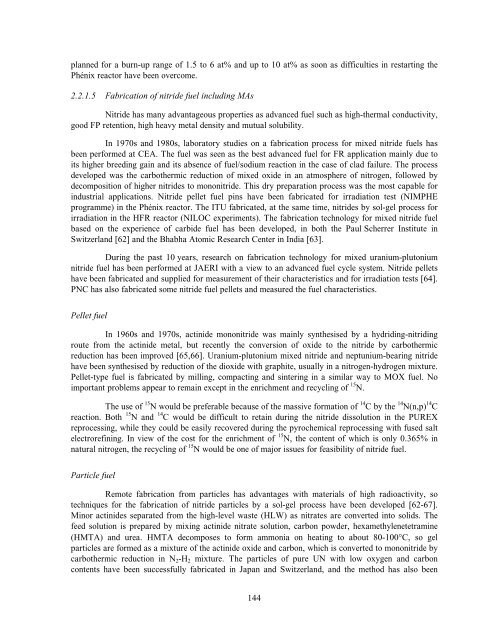COMPLETE DOCUMENT (1862 kb) - OECD Nuclear Energy Agency
COMPLETE DOCUMENT (1862 kb) - OECD Nuclear Energy Agency
COMPLETE DOCUMENT (1862 kb) - OECD Nuclear Energy Agency
Create successful ePaper yourself
Turn your PDF publications into a flip-book with our unique Google optimized e-Paper software.
planned for a burn-up range of 1.5 to 6 at% and up to 10 at% as soon as difficulties in restarting the<br />
Phénix reactor have been overcome.<br />
2.2.1.5 Fabrication of nitride fuel including MAs<br />
Nitride has many advantageous properties as advanced fuel such as high-thermal conductivity,<br />
good FP retention, high heavy metal density and mutual solubility.<br />
In 1970s and 1980s, laboratory studies on a fabrication process for mixed nitride fuels has<br />
been performed at CEA. The fuel was seen as the best advanced fuel for FR application mainly due to<br />
its higher breeding gain and its absence of fuel/sodium reaction in the case of clad failure. The process<br />
developed was the carbothermic reduction of mixed oxide in an atmosphere of nitrogen, followed by<br />
decomposition of higher nitrides to mononitride. This dry preparation process was the most capable for<br />
industrial applications. Nitride pellet fuel pins have been fabricated for irradiation test (NIMPHE<br />
programme) in the Phénix reactor. The ITU fabricated, at the same time, nitrides by sol-gel process for<br />
irradiation in the HFR reactor (NILOC experiments). The fabrication technology for mixed nitride fuel<br />
based on the experience of carbide fuel has been developed, in both the Paul Scherrer Institute in<br />
Switzerland [62] and the Bhabha Atomic Research Center in India [63].<br />
During the past 10 years, research on fabrication technology for mixed uranium-plutonium<br />
nitride fuel has been performed at JAERI with a view to an advanced fuel cycle system. Nitride pellets<br />
have been fabricated and supplied for measurement of their characteristics and for irradiation tests [64].<br />
PNC has also fabricated some nitride fuel pellets and measured the fuel characteristics.<br />
Pellet fuel<br />
In 1960s and 1970s, actinide mononitride was mainly synthesised by a hydriding-nitriding<br />
route from the actinide metal, but recently the conversion of oxide to the nitride by carbothermic<br />
reduction has been improved [65,66]. Uranium-plutonium mixed nitride and neptunium-bearing nitride<br />
have been synthesised by reduction of the dioxide with graphite, usually in a nitrogen-hydrogen mixture.<br />
Pellet-type fuel is fabricated by milling, compacting and sintering in a similar way to MOX fuel. No<br />
important problems appear to remain except in the enrichment and recycling of 15 N.<br />
The use of 15 N would be preferable because of the massive formation of 14 C by the 14 N(n,p) 14 C<br />
reaction. Both 15 N and 14 C would be difficult to retain during the nitride dissolution in the PUREX<br />
reprocessing, while they could be easily recovered during the pyrochemical reprocessing with fused salt<br />
electrorefining. In view of the cost for the enrichment of 15 N, the content of which is only 0.365% in<br />
natural nitrogen, the recycling of 15 N would be one of major issues for feasibility of nitride fuel.<br />
Particle fuel<br />
Remote fabrication from particles has advantages with materials of high radioactivity, so<br />
techniques for the fabrication of nitride particles by a sol-gel process have been developed [62-67].<br />
Minor actinides separated from the high-level waste (HLW) as nitrates are converted into solids. The<br />
feed solution is prepared by mixing actinide nitrate solution, carbon powder, hexamethylenetetramine<br />
(HMTA) and urea. HMTA decomposes to form ammonia on heating to about 80-100°C, so gel<br />
particles are formed as a mixture of the actinide oxide and carbon, which is converted to mononitride by<br />
carbothermic reduction in N 2 -H 2 mixture. The particles of pure UN with low oxygen and carbon<br />
contents have been successfully fabricated in Japan and Switzerland, and the method has also been<br />
144
















